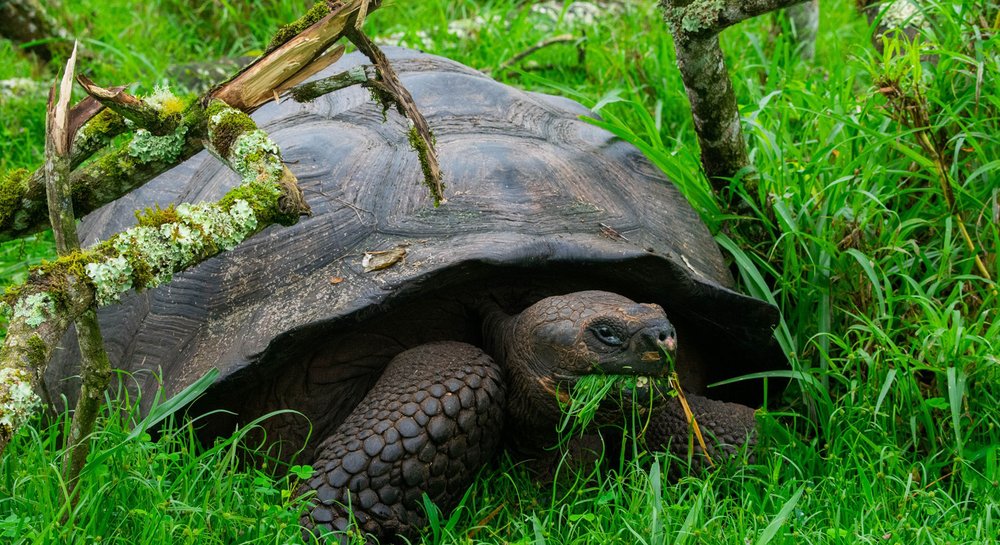Scientists from the Charles Darwin Foundation (CDF), the Saint Louis Zoo Institute for Conservation Medicine (ICM), the Animal Health Research Center (INIA-CISA), the Complutense University, and the European University of Madrid, together with technicians from the Galapagos National Park Directorate (GNPD) showed that one of the most emblematic species on Earth, the giant tortoises of Galapagos, carry antibiotic resistance bacteria associated with human activities in the archipelago.
This research showed that a greater quantity of resistant bacteria is present in tortoises that share their habitat with human settlements (i.e., agricultural, urban, and tourist areas) than tortoises living at remote areas, such as the Alcedo Volcano on Isabela Island.
These results were verified after analyzing the fecal samples of 270 tortoises. Scientists searched for a total of 21 genes that encode resistance to eight different classes of antibiotics, commonly used in human and veterinary medicine, as well as growth promoters in farm animals.

"Antibiotic resistance is spreading around the world causing an invisible pandemic that compromises the health and treatment of humans and animals." explains Dr. Ainoa Nieto Claudín, first author of this work, PhD student and researcher at the CDF and ICM.
Researchers around the world are working together to better understand the origins, transmission, and impacts associated with these “superbugs”, as international health agencies have designated the study of antimicrobial resistance as one of the top priorities of political agendas.
"The Covid-19 pandemic has increased the use of antibiotics and, consequently, the emergence of resistant bacteria around the world. The animal-human interface creates the perfect scenario for resistance to enter wild species and contaminate their habitat, perpetuating the resistance transmission cycle,” adds Dr. Nieto Claudín.
Research conducted as part of the Galapagos Tortoise Movement Ecology Program (GTMEP) showed that giant tortoises are key species for the archipelago's ecosystems. They are considered Galapagos engineers and gardeners, due to their role in the dispersal of seeds and the modification of the ecosystems. Increased tourism, habitat fragmentation, introduced species, and climate change are just a few of the many threats that Galapagos tortoises face today.
Dr. Sharon L. Deem, Director of the ICM and a co-author on the paper comments:
“Galapagos tortoises are migratory species on islands like Santa Cruz, the most populated in the archipelago. Here, tortoises often leave the protection of the National Park and enter private lands during their annual migrations. Galapagos tortoises may spend more than six months a year in urban and agricultural areas, where they encounter new threats such as impacts from cars, plastic ingestion, and exposure to resistant bacteria and pesticides.”
Wildlife such as Galapagos tortoises may act as sentinels of the health of the ecosystems where they live. Fernando Esperón, co-author of the paper and professor at the European University of Madrid explains:
“It is essential to continue with studies of this caliber in emblematic species such as giant tortoises, to better understand how these resistant bacteria spread, proposing solutions to a global crisis that threatens the health of both people and animals.”
But it is not all bad news. Knowing the places where there is more antimicrobial resistance within the human-populated areas of Galapagos allows us to coordinate management actions with local institutions to control the use of antibiotics and raise awareness among local farmers. Furthermore, the data produced by this study suggest that levels of antibiotic resistance found are low, when compared to other studies carried out in large continental cities. This suggests that the situation in the Galapagos could be reversible if scientists, decision-makers, and the local community join efforts to regulate and reduce the use of antibiotics in the archipelago.
This research was published in the journal of Environmental Pollution, which can be accessed through this link: https://www.sciencedirect.com/science/article/pii/S0269749121010356





